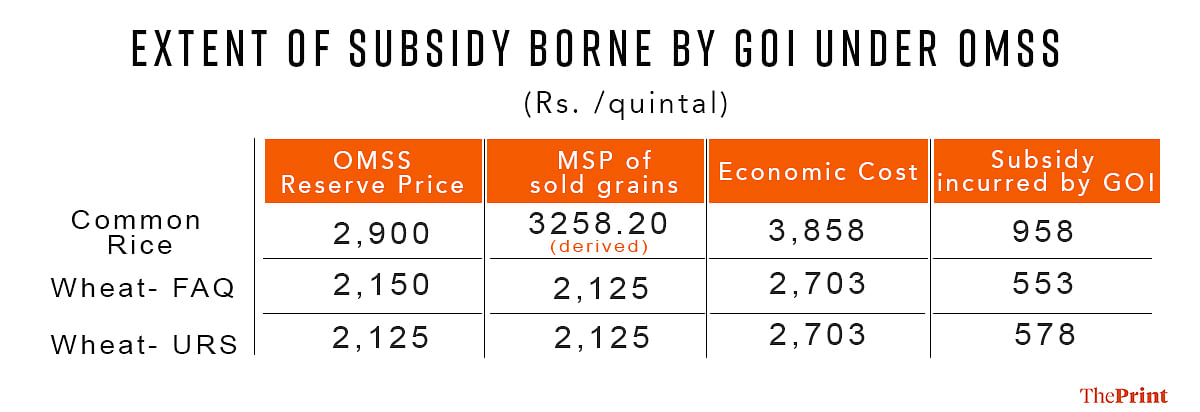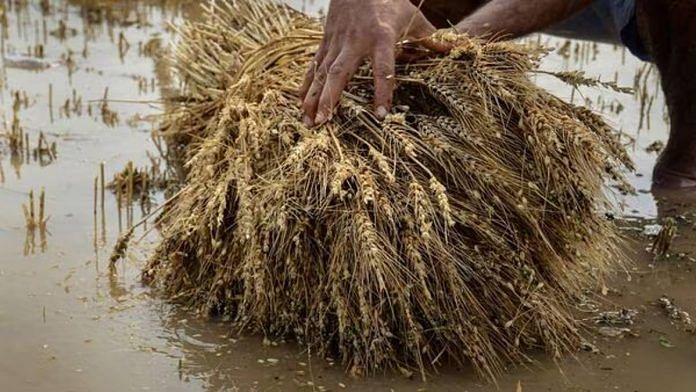To check high inflation in basic cereals, wheat and rice, the central government has been highly proactive, and has implemented several measures in the last two years.
Sale of wheat and rice from government-held central pool stocks, referred to as the open market sale scheme (OMSS), is an important policy tool. The OMSS has been quite successful as there are bulk consumers (flour mills) who purchase wheat offered for sale. However, the government has not been able to find buyers for rice.
For several years, experts have been worrying over excessive procurement and resultant buildup of wheat and rice stock in the central pool. The OMSS has been used to reduce excessive stocks in the past.
The committee appointed by the Supreme Court to examine the three farm laws enacted in 2021 recommended capping the procurement of wheat and rice to a level sufficient for the Public Distribution System (PDS).
However, the narrative in the country changed when climate change affected the production of even staple crops of rice and wheat. In the last two years, unusually high temperatures in February and March, and unseasonal rains and hailstorms closer to harvest times damaged wheat crops. And erratic and uneven monsoon has impacted rice production. With lower crops and open exports, domestic availability squeezed, leading to an increase in prices. In November 2023, the cost of wheat for consumers increased by 6.4 per cent. This rise was on top of the 20 per cent increase in November 2022. In the case of rice, the annual inflation was about 11.8 per cent over and above the 10.5 per cent last year.
OMSS to tame inflation
In the current financial year, the government of India has allocated 1.5 million tonnes of wheat and 2.5 million tonnes of rice for the OMSS. They are offered at Rs. 2,150 and Rs 2,900 per quintal respectively. The minimum support price (MSP) of wheat and paddy is Rs 2,125 and Rs 2,183 per quintal respectively.
The derived cost of rice, considered a 67 per cent recovery rate, comes to Rs 3,258.20 per quintal. The government also bears the cost of transportation, handling, interest, administrative charges, and losses, thereby increasing the total cost, known as economic cost, to Rs. 2,703 per quintal for wheat and Rs 3,858 per quintal for rice.
By offering cereal at discounted prices under OMSS, the government is incurring a subsidy cost of Rs 553-578 per quintal on wheat and Rs 958 per quintal on common rice.

Also read: Assembly polls did what farmers’ protests couldn’t—Swaminathan formula MSP for paddy & wheat
Performance of wheat under OMSS
Given the high open market prices, the subsidised wheat offered under the OMSS is quickly purchased by bulk buyers like flour mills. It must be noted that the price of wheat flour (atta) is not controlled by the government.
In a recent decision, the Centre has also decided to use its wheat stock to sell flour under the brand name Bharat Atta. It plans to release 4 lakh tonnes of wheat at Rs 2,150 per quintal to the National Agricultural Cooperative Marketing Federation of India Limited (NAFED), National Cooperative Consumers’ Federation of India Limited (NCCF) and Kendriya Bhandar. Bharat Atta will be available to the general consumer at Rs 27.50 per kg.
The per kg retail rate of wheat flour in the open market on 1 January 2024 was about Rs 47 in Andhra Pradesh, Kerala and Karnataka, Rs 50 in Telangana and Rs 54 in Tamil Nadu. In Haryana, Madhya Pradesh and Uttarakhand, prices were about Rs 33-34 per kg. So, the availability of Bharat Atta at Rs 27.50 would greatly benefit households if it were easily available.
But organisations such as NAFED and NCCF have a limited presence across India. New Delhi is the only city where their outlets are available in large numbers. In rural India, there are hardly any retail outlets directly run by them.
Therefore, the availability of Bharat Atta is likely to have a little impact on market prices overall, especially in states where wheat flour prices are high.
Rice under OMSS
Unlike wheat, performance of rice under OMSS has been poorer. The government allocated 25 lakh tonnes of rice under the OMSS at the rate of Rs 2,900 per quintal in 2023. But the response from private trade has been very poor and as of 15 December 15 2023, only 1.19 lakh tonnes of rice could be sold.
In Punjab, Chhattisgarh, Bihar and Uttar Pradesh, retail price of rice on 1 January 2024 was about Rs 38 per kg while it was much higher in Andhra Pradesh (Rs 560), Tamil Nadu (Rs 59), Kerala (Rs 51) and Karnataka (Rs 58). So, there should have been much higher demand for the OMSS rice (offered at Rs 29 per kg).
Also read: India could have sailed August rain deficit but MGNREGS failing in water conservation
The Bangladesh example
Bangladesh also runs an Open Market Sale (OMS) for the poor and low-income families in addition to its Public Food Distribution System. Rice is sold at Taka (Tk) 30 per kg (Rs 22.75) and wheat flour at Tk 17 per kg (Rs 12.88). A family can purchase a maximum of five kg of rice and two packets of 2 kg flour.
The trucks selling these items are stationed in working class localities in Dhaka, Chittagong, and Khulna among other locations but the overall quantity offered is limited and there are long queues. But in terms of targeting, it still seems to be better than the OMSS in India.
For India, a way to better target the OMSS for both wheat flour and rice is to set up distribution through NAFED, NCCF and state-level organisations by using mobile vehicles. However, this should only be done in economically weaker states and those with high inflation. In other states, the target should be to reach areas inhabited by working classes rather than Kendriya Bhandars, which are mostly used by government officials.
This would mean moving away from New Delhi (which has the highest per capita income in India) and going to Bihar, Jharkhand, Odisha and other such states. The government must also evaluate the effectiveness of wheat sales to bulk consumers.
Siraj Hussain is a former Union Agriculture Secretary. Shweta Saini, an economist, is the CEO of Arcus Policy Research. Views are personal.
(Edited by Ratan Priya)



